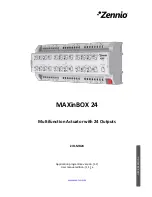
CY8CKIT-147 PSoC® 4100PS Prototyping Kit Guide, Doc. #: 002-18734 Rev. *D
34
A.2.3
Power Supply System
The power supply system on this board is dependent on the source of the power. For most
applications, you can use the 5 V supply from the USB connection to power the system. You can
also connect an external power supply to the board for low-voltage applications. The kit supports the
following connections:
■
5 V from the KitProg2 USB (J8)
■
1.8 V to 5 V from a regulated supply connected to VTARG or VDDD
Note:
In order to use an external power supply with the KitProg2 also connected to the PC USB, first
remove diode D1 from the board. This ensures that the VTARG supply from KitProg2 is not supplied
to the target device. KitProg2 measures the target voltage and adjusts the logic levels on the pro-
gramming pins accordingly.
It is important to understand that this prototyping kit does not have any onboard ESD protection
circuitry. Therefore, the power source for the PSoC 4100PS Prototyping kit must be of a high quality
to ensure that the board is protected from any over-current conditions and swapped-power
connections.
A.2.3.1
Measure PSoC 4100PS Current Consumption
You can measure current consumption of the PSoC 4100PS device by following the steps below.
1. Remove the resistors R31, R3 and install a 2-pin jumper in the supplied holes of J3.
2. Connect an ammeter across the 2-pin jumper to measure the current to the PSoC 4100PS
device.
After measuring the current consumption, populate resistors R31 and R3 or place a shorting jumper
across the two jumper pins for normal operation of the kit.
A.2.4
Board Separation (Snapping)
The PSoC 4100PS Prototyping kit consists of a PSoC 4100PS and a KitProg2 board. To separate
the two boards for evaluation or development, break the two boards apart at the built-in perforated
edge between J4 and J5.
The easiest method of separating the two boards is to place the kit on the edge of a table, where the
edge of the table is directly below the perforated edge and the smaller KitProg2 board is off the table
edge. Press gently on the KitProg2 board and snap the two boards apart. If any material is removed
from the edge of the boards, use sheers to clean up the edge of the kit.
Note that once the boards are separated, direct UART and I2C connections between the
PSoC 4100PS device and KitProg2 are lost. This is because the traces connecting the UART and
I2C lines are cut off during the separation. However, you can access KitProg2’s UART and I2C lines
through header J6.
Figure A-4. PSoC 4100PS Prototyping kit Broken into Two Parts












































